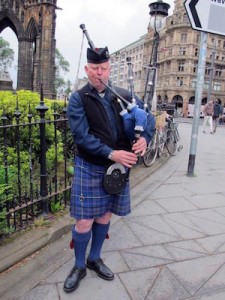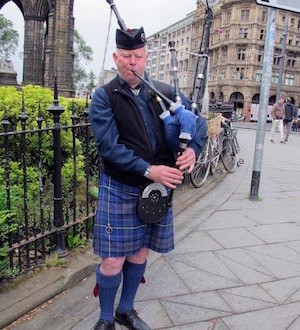 ‘Fifty Shades of Grey,’ mumbled John under his breath as the city of Edinburgh came into view. And it was true, the sky, the streets and the towering buildings were all clothed in myriad shades of moody greys, Edinburgh in summer!
‘Fifty Shades of Grey,’ mumbled John under his breath as the city of Edinburgh came into view. And it was true, the sky, the streets and the towering buildings were all clothed in myriad shades of moody greys, Edinburgh in summer!
A beautiful sight – but Edinburgh was not always so gracious. In the 18th Century it was hugely crowded and smelly and known as Auld Reekie. Its citizens had the disgusting habit of throwing the contents of their chamber pots out in the street at 10 pm each evening for scavengers employed by the council to remove the next morning.
After a wee restie in the afternoon we put on our walking shoes and went climbing in Holyrood Park almost all the way up to Arthur’s seat (its highest point and a dormant volcano) to enjoy a panoramic view of the city.
The four of us dined that evening in Canons Gait Bar. Along with some fine Scottish craft beers they have a reputation for good pub food. Wanting to sample as many different dishes as possible we ordered most of the entrees on the menu to create our own ‘Scottish tapas’ experience, to the amusement of the obliging waitress. The most memorable were the Haggis in beer batter with whiskey sauce, black pudding in a spicy tomato chutney and Scottish pork cheek, pancetta and wild mushrooms.
Our apartment in Edinburgh was at Old Tolbooth Wynd at the end of a short cobble-stoned street and just off the main street, the Royal Mile. We walked the length of it but were not tempted by most of the touristy ‘tartan tat’. At the top end of the Royal Mile the entrance to Edinburgh Castle was so crowded with schoolkids and tourists that we decided to give Edinburgh’s most famous tourist attraction a miss.
A free walking tour is a great introduction to a city (but of course you’ll want to leave a generous tip). Ours (Sandeman’s New Edinburgh Tour) was led by amusing lad called Johnny who kept us spellbound for three hours with anecdotes about its famous and infamous people and places.
The infamous Deacon Brodie was a highly respected citizen during the day but a robber by night. He was finally caught and hanged. And then there was Maggie Dixon, a poor young woman impregnated by her employer’s son and accused of infanticide. Against all odds she survived her hanging and was granted a full pardon.
A host of famous philosophers, authors, scientists, theologians and writers have come from Edinburgh, almost all men. One of the few women on the famous list is JK Rowling, who wrote the first Harry Potter book in Edinburgh’s Elephant House Cafe with baby Jessica alongside in her pram.
We saw George Heriot’s school, her inspiration for Hogwarts castle, which our granddaughters who are ardent Harry Potter fans will be keen to hear about. And at Greyfriar’s Kirk yard we peeked at the tombstone which supposedly inspired the creation of Lord Voldemort’s character.
The most enchanting story was that of Bobby of Greyfriar’s, a loyal little Skye terrier who maintained a vigil by his owner’s grave for 14 years after John Gray died. His statue still stands in the graveyard. Some now doubt its veracity and say the whole story was just a Victorian publicity stunt.
After a couple of days in Edinburgh we bid a fond farewell to my intrepid sister and brother in law. We had loved their company on our travels around Great Britain, but they needed to be back in London in time to catch their plane to Tanzania for a Wild Life Safari.
During the rest of our sojourn in Edinburgh the two of us binged on Scottish culture and explored its museums both large and small, and the impressive National Art Gallery.
We also visited St Giles Cathedral, built in the 14th century, and which still looks more Catholic than Presbyterian. I was disappointed to find the Thistle Chapel was closed so we never did get to see its famous carving of angels playing the bagpipes.
A highlight was a visit to two National Trust Scotland Houses both beautifully restored and with very informative and chatty volunteers to show us around. This gave us a glimpse into two very different kinds of lives that were lived in the Medieval (the old part of the city) and the later Georgian (New Town)
On our last morning we walked a mile out of the city to the Royal Botanical Gardens which had been founded in 1670 as a physic garden to study the science of healing. Spread over 72 acres it has many unusual and beautiful plants. We strolled around a small part of it but before too long, in need of a caffeine fix, we headed for the café, and afterwards browsed in their classy but expensive gift shop.
Many art and cultural festivals take place in Edinburgh each summer when the streets are buzzing with musicians, markets and live shows but none while we were there. We only came across one solitary busker dressed in a kilt playing the bagpipes.
But we thought it a great place to visit with so much to see and enjoy and all within easy walking distance. And of course we allowed ourselves plenty of time in between seeing the sights to have a few leisurely pints at ancient local pubs.









Join the Discussion
Type out your comment here:
You must be logged in to post a comment.